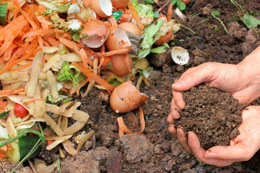Composting is the natural way of breaking down moist, organic materials into simpler forms under controlled aerobic conditions. This section gives a complete description about the composting process.

Compost is a primary source for plant nutrients in organic gardening. Farmyard compost is a common addition to garden soil preparations. This eco-friendly plant fertilizer is the main product of composting. It also works in yielding soil conditioners.
The Basics
Any organic material obtained from living things (vegetables, plants, or animals) can be decomposed into nutritious particles for plants. Composting involves recycling the nutrients to increase soil fertility. Compost is a type of organic fertilizer for the soil that is useful in supporting plant life. Besides growing healthy plants and flowers, this procedure indirectly helps in maintaining a cleaner home and surroundings.
This process is of three types depending on the type of organic matter you are using. The first method is backyard composting, in which you can compost all the backyard waste, including leaves, branches that have been pruned, grass clippings, and food scraps. The second type is vermicomposting or worm composting, which involves the use of earthworms for decomposition of food remains and kitchen waste. If you have a lawn, go for the third and last type called grasscycling, where the organic matter is exclusively made up of grass clippings.
How it Works
This process occurs naturally where there is a source of organic matter, and favorable environmental conditions. It is a known fact that the topsoil of a thick forest is fertile and rich in humus soil. The soil fertility in the area is contributed to by the leaves and plant parts that fall from large trees. This pile of solid, organic matter undergoes decomposition with the help of microorganisms, resulting in humus soil. This natural process is referred to as mulching, and when it is tried in a controlled environment, it is called composting.
Microbes (bacteria, fungi, and actinomycetes) play a major role in transforming organic materials into the nutrient form. For this process to take place efficiently, there are certain requirements that need to be fulfilled, apart from the availability of organic matter. The objective is to create favorable conditions for the microbes to remain in an active state. Maintaining optimal temperature (155° F), moisture content (45 percent), and air circulation is essential. Hence, you should not saturate the decomposing materials with water. Another important factor is the carbon to nitrogen ratio, which should fall within a specific range (30:1 in dry weight).
Composting at Home
It is essential that you make use of proper equipment when taking up composting at home. Nowadays, compost bins having slots for air circulation are sold in home supply stores. You should feed only biodegradable, organic wastes into the bin, making sure that the particle size is 2-3 inches. Also, maintain the above mentioned range for temperature, moisture content, and carbon to nitrogen ratio. While very low temperatures negatively affect the microbial activity, high temperatures kill them. Likewise, air circulation is crucial to increase microbial action. For proper aeration, you can consider using a rotating bin instead of a regular one.
The resulting compost resembles the crumbly, dark brown humus soil which you use in lawns, vegetable gardens, and other gardening projects. By undertaking composting, you can have a continuous supply of natural fertilizer for organic gardening. It is a step forward to sustainable agriculture and chemical-free, home-grown vegetables.






 Compost is a primary source for plant nutrients in organic gardening. Farmyard compost is a common addition to garden soil preparations. This eco-friendly plant fertilizer is the main product of composting. It also works in yielding soil conditioners.
Compost is a primary source for plant nutrients in organic gardening. Farmyard compost is a common addition to garden soil preparations. This eco-friendly plant fertilizer is the main product of composting. It also works in yielding soil conditioners.